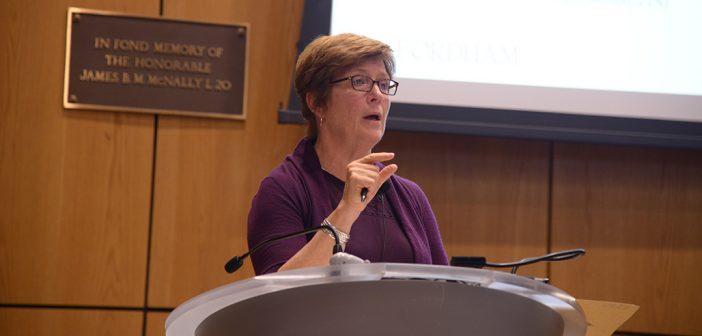On Nov. 1 and Nov. 2, Martha K. Hirst, Fordham’s senior vice president, chief financial officer, and treasurer broke down the specifics of the University’s $791 million fiscal year 2018 budget in forums designed to educate the Fordham community on University finances.
Hirst noted that, far from being a dry collection of numbers, the budget is in fact a statement of Fordham’s true priorities.
“The budget allows Fordham to exist, thrive, grow, and endure as the University fulfills its essential commitment to transformative teaching, research, and service. It helps to ensure that our students leave Fordham with the restlessness of mind and soul that Father [Joseph M.] McShane calls ‘bothered excellence,’” she said.
“That’s a tall order, and it is expensive,” said Hirst.
Hirst conducted the forums at the Rose Hill and Lincoln Center campuses. She outlined how in many ways, the budget is a living document. Planning takes place in the summer, building on those plans takes place in the fall, adjustments come in the winter, and in the spring, a proposed budget is presented to the Board of Trustees for approval. In the 2018 fiscal year, tuition and fees collected from 8,410 undergraduate students and 6,600 graduate students account for $663 million, or 84 percent of the budget. The remaining $84 million comes from auxiliary revenues such as housing and food services, while another $44 million comes from sources such as grants and gifts.
A significant amount of that revenue is spent on financial aid, with $212 million going toward both undergraduate and graduate students, she said. Undergraduate students receive $175 million, an amount that has increased by $75 million since 2012. This results in a “discount rate” of 47 percent, compared to the national average of 49 percent. So, although the sticker price for undergraduate admission is currently $49,645 a year, only 10 percent of first-year students pay that full price; the discount averages $26,611 a year per student.
Hirst said salaries and wages account for another $260 million in expenditures, and fringe benefits such as health insurance account for another $43 million. Other costs include FICA, tuition remission and exchange, retirement expenses, security and maintenance, depreciation, interest on debt, and other contingencies.
As the presentation illustrated, Fordham invests in affordability for students and their families, excellence in students’ academic, residential and co-curricular experiences and in the first-rate University faculty and staff who work to shape those experiences.
Looking to the future, Hirst said the outlook is bright but challenging. On the plus side, the University maintains a balanced budget and spends no more than it takes in. Of concern, however, is the fact that the $300,000 budgeted to be on hand at the end of Fiscal 2018 is not enough for weathering enrollment and other ups and downs and for investment in future initiatives. The ideal amount for colleges and universities to have on hand is 3% to 5% of their operating budgets, which for Fordham is $15-$20 million.
Academic institutions have at their disposal many options for increasing revenue and reducing costs, and Hirst reviewed 18 common strategies, grouped together as efficiencies, cost reduction, revenue growth or real estate. Some strategies, like selling buildings or outsourcing support services, might not be workable for Fordham at this time. But these and others, such as expanding online learning initiatives, re-evaluating poorly performing initiatives, and initiating voluntary separation and early retirement programs, should all be considered in the on-going conversation.
“An important thing to recall is that our story is a very long one—176 years so far. It has many chapters and we are really sort of passing through,” Hirst said. “We are stewards and, in all the ways we use our budget, the most important thing for us to think about is to manage today, but also plan for tomorrow.”
Watch the full presentation:
Download the Powerpoint here.



